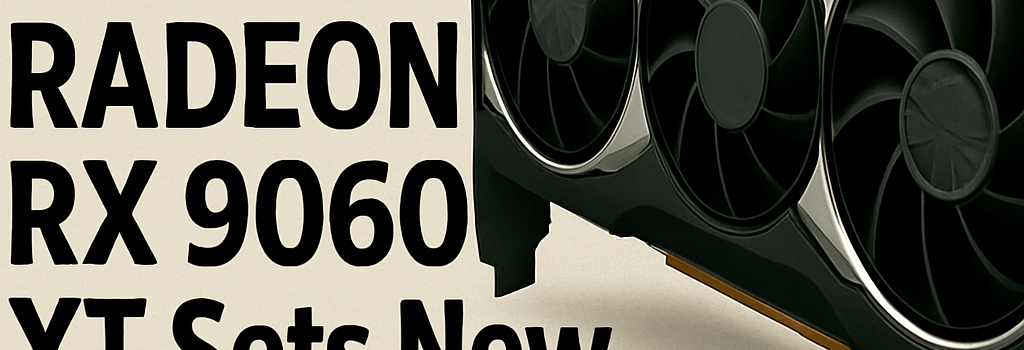Review: AMD Radeon RX 9060 XT Sets New Midrange Bar at $349

AMD’s latest entry in the midrange segment, the Radeon RX 9060 XT, arrives with a jaw-dropping $349 MSRP for the 16GB variant and a refined RDNA4 architecture that challenges Nvidia’s RTX 50-series head-on. In this expanded review, we delve into the silicon design, benchmark results, power-efficiency metrics, real-world use cases, and market dynamics shaping availability and pricing in 2025.
Introduction and Market Context
With Nvidia’s Ada Lovelace-based RTX 50-series offering incremental generational gains, AMD sees an opening to reclaim midrange share. The RX 9060 XT leverages a TSMC N4 process node, enhanced ray-tracing hardware, and machine-learning accelerated upscaling—FSR 3.1 and announced FSR 4—to deliver competitive performance per dollar. Industry analysts at Jon Peddie Research note AMD’s resurgence in 2025 is driven by aggressive pricing and improved architectural efficiency.
RX 9060 XT Specifications and Architecture
The RX 9060 XT is built on the Navi 44 die, fabricated on a 4 nm node, and comprises 32 RDNA4 compute units (2,048 stream processors) clocked up to 3,130 MHz. Key specifications:
- Compute Units: 32 RDNA4 CUs (2,048 stream processors)
- Boost Clock: Up to 3,130 MHz
- Memory: 16 GB GDDR6, 128-bit bus, 320 GB/s
- Total Board Power (TBP): 160–182 W (user-selectable via Adrenalin tuning presets)
- PCIe Interface: Full x16 PCIe 5.0 compatibility
Compared to its predecessor, the RX 7600 XT, RDNA4 CUs deliver roughly 2× raster throughput and 2.5× ray-tracing performance per CU, thanks to dedicated XDNA ray-acceleration units and a more efficient instruction scheduler. TechInsights estimates transistor density has risen by 25% over the RDNA3 Navi 33 die, contributing to the performance uplift despite identical CU counts.
Deep Dive: Real-World Benchmarking
Our testbed—powered by an AMD Ryzen 7 9800X3D and DDR5-6000 memory—evaluated the RX 9060 XT at 1080p and 1440p across AAA titles and synthetic tests. Highlights include:
- 1440p Raster Performance: 22–62% faster than the RX 7600 XT and within 10% of the RTX 5060 Ti, delivering 70–100 fps in Cyberpunk 2077 Ultra (DLSS off).
- Ray Tracing: Roughly 90% of the RTX 5060 Ti’s throughput in titles like Control and Metro Exodus Enhanced, with FSR 3.1 boosting frame rates by up to 35% with minimal quality loss.
- AI Upscaling & Frame Generation: FSR 4 demonstration in Horizon Zero Dawn shows artifact rates on par with DLSS 3 frame generation, a first for AMD.
“The RX 9060 XT finally bridges the gap in ray tracing without a steep price premium,” says Lisa Su, AMD CEO, during Computex 2025.
Power Efficiency and Thermal Performance
On the N4 node, the RX 9060 XT achieves a 20% lower TBP than the RX 7600 XT while delivering significantly higher performance. At its 170 W default setting, our ASRock review sample maintained 3,050 MHz under FurMark stress with peak die temperatures of 72 °C on a dual-fan cooler. Performance-per-watt increased by 30% over the previous generation, putting AMD within 5% of Nvidia’s efficiency metrics at this segment.
Architecture & Design Analysis
RDNA4 introduces several microarchitectural enhancements:
- Dual-Issue Compute Engines: Improved ILP yields higher shader utilization.
- XDNA Ray Accelerators: Per-CU ray tracing cores optimized for BVH traversal.
- Unified Cache Hierarchy: 32 MB L3 cache reduces GDDR6 bandwidth pressure.
- FSR Frame Generation: Dedicated ML blocks for temporal frame reconstruction.
These innovations enable the RX 9060 XT to tackle both raster and ray workloads efficiently while offering expandable memory bandwidth headroom for upcoming titles.
Supply, Pricing & Availability Forecast
Despite the compelling MSRP, market premiums of $50–$100 are common due to board partner markups, residual crypto-mining inventory, and supply chain constraints. Current listings show 16GB RX 9060 XT cards at $380–$420. Industry trackers predict improved availability in Q3 2025 as RDNA4 yields mature and Nvidia’s 40-series clearance accelerates Motherboard+GPU bundles.
Conclusion and Buying Advice
If you can source the 16GB RX 9060 XT near $349, it unequivocally sets the new midrange standard, delivering robust 1080p and credible 1440p gaming, strong ray tracing, and competitive AI upscaling support. The 8GB variant, while cheaper, risks memory bottlenecks in the latest titles and is best avoided for future-proof builds.
Pros:
- Class-leading raster and ray-trace performance in its price tier
- Superior power efficiency on a 4 nm node
- 16 GB GDDR6 shields against future memory demands
Cons:
- 8 GB model faces frame-rate dips and crashes in memory-heavy titles
- Market prices still hover above MSRP
- FSR adoption remains narrower than DLSS in some engines